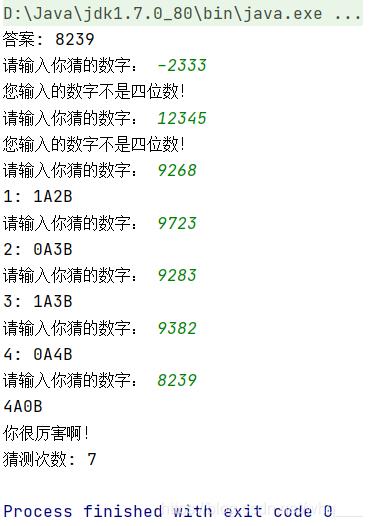java實(shí)現(xiàn)簡(jiǎn)單的猜數(shù)字小游戲
本文實(shí)例為大家分享了java實(shí)現(xiàn)簡(jiǎn)單的猜數(shù)字的具體代碼,供大家參考,具體內(nèi)容如下
題目描述:
猜數(shù)字(又稱 Bulls and Cows )是一種古老的的密碼破譯類益智類小游戲,起源于20世紀(jì)中期,一般由兩個(gè)人或多人玩,也可以由一個(gè)人和電腦玩。通常由兩個(gè)人玩,一方出數(shù)字,一方猜。出數(shù)字的人要想好一個(gè)沒有重復(fù)數(shù)字的4個(gè)數(shù),不能讓猜的人知道。猜的人就可以開始猜。每猜一個(gè)數(shù)字,出數(shù)者就要根據(jù)這個(gè)數(shù)字給出nAmB,其中A前面的數(shù)字n表示數(shù)字正確且位置也正確的數(shù)的個(gè)數(shù),而B前的數(shù)字m表示數(shù)字正確但位置不正確的數(shù)的個(gè)數(shù)。如正確答案為 5234,而猜的人猜 5346,則是 1A2B,其中有一個(gè)5的位置對(duì)了,記為1A,而3和4這兩個(gè)數(shù)字對(duì)了,而位置沒對(duì),因此記為 2B,合起來就是 1A2B。接著猜的人再根據(jù)出題者的幾A幾B繼續(xù)猜,直到猜中(即 4A0B)為止。
程序要求:
1、滿足題意 2、輸入數(shù)字的合法性3、輸出總猜測(cè)次數(shù)
代碼
package Practice;// 猜數(shù)字 (Bulls and cows)import java.util.Scanner;public class Day0322 { public static void main(String[] args) { Scanner scanner = new Scanner(System.in); // 產(chǎn)生0000~9999的隨機(jī)數(shù) double r = Math.random(); int res = (int)(r * 8999 + 1000); int flag = 0; // 合法性檢查,判斷存在重復(fù)數(shù)字 while(flag == 0) { int[] check = new int[10]; for(int i = 0; i < 10; i ++ ) check[i] = 0; check[res / 1000] += 1;check[(res / 100) % 10] += 1; check[(res / 10) % 10] += 1;check[res % 10] += 1; for(int i = 0; i < 10; i ++ ) if(check[i] >= 2) { r = Math.random(); res = (int)(r * 8999 + 1000); flag = 0; break; } else flag = 1; } // 0000~9999 System.out.println('答案: ' + res); int input = -1; int idx = 0; int times = 0; while(input != res) { System.out.print('請(qǐng)輸入你猜的數(shù)字: '); input = scanner.nextInt(); int inputcopy = input; if(input < 0) { System.out.println('您輸入的數(shù)字不是四位數(shù)!'); times ++; continue; } int t = 0; // 輸入數(shù)字為4位數(shù),合法性檢查 while(inputcopy != 0) { inputcopy /= 10; t ++; } if(t != 4) { System.out.println('您輸入的數(shù)字不是四位數(shù)!'); times ++; continue; } int n = 0, m = 0;// nAmB if(input == res) break; // 輸入的各個(gè)位數(shù) int[] a = new int[4]; a[0] = input / 1000;a[1] = (input / 100) % 10; a[2] = (input / 10) % 10; a[3] = (input) % 10; // 答案的各個(gè)位數(shù) int[] ans = new int[4]; ans[0] = res / 1000;ans[1] = (res / 100) % 10; ans[2] = (res / 10) % 10; ans[3] = (res) % 10; for(int i = 0; i < 4; i ++) { if(ans[i] == a[i]) n += 1; // A的數(shù)量 for(int j = 0; j < 4; j ++){// B的數(shù)量 if(ans[j] == a[i] && j != i) m += 1; } } System.out.print((++ idx) + ': ' + n + 'A' + m + 'B'); System.out.println(); times ++; } if(input == res){ times ++; System.out.println('4A0B'); System.out.println('你很厲害啊!'); System.out.println('猜測(cè)次數(shù): ' + times); } }}
運(yùn)行效果

以上就是本文的全部?jī)?nèi)容,希望對(duì)大家的學(xué)習(xí)有所幫助,也希望大家多多支持好吧啦網(wǎng)。
相關(guān)文章:
1. python爬蟲實(shí)戰(zhàn)之制作屬于自己的一個(gè)IP代理模塊2. 基于javaweb+jsp實(shí)現(xiàn)企業(yè)財(cái)務(wù)記賬管理系統(tǒng)3. .NET6打包部署到Windows Service的全過程4. 解決ajax請(qǐng)求后臺(tái),有時(shí)收不到返回值的問題5. HTML 絕對(duì)路徑與相對(duì)路徑概念詳細(xì)6. Python編寫nmap掃描工具7. Ajax返回值類型與用法實(shí)例分析8. .Net Core和RabbitMQ限制循環(huán)消費(fèi)的方法9. 使用FormData進(jìn)行Ajax請(qǐng)求上傳文件的實(shí)例代碼10. 如何在jsp界面中插入圖片

 網(wǎng)公網(wǎng)安備
網(wǎng)公網(wǎng)安備